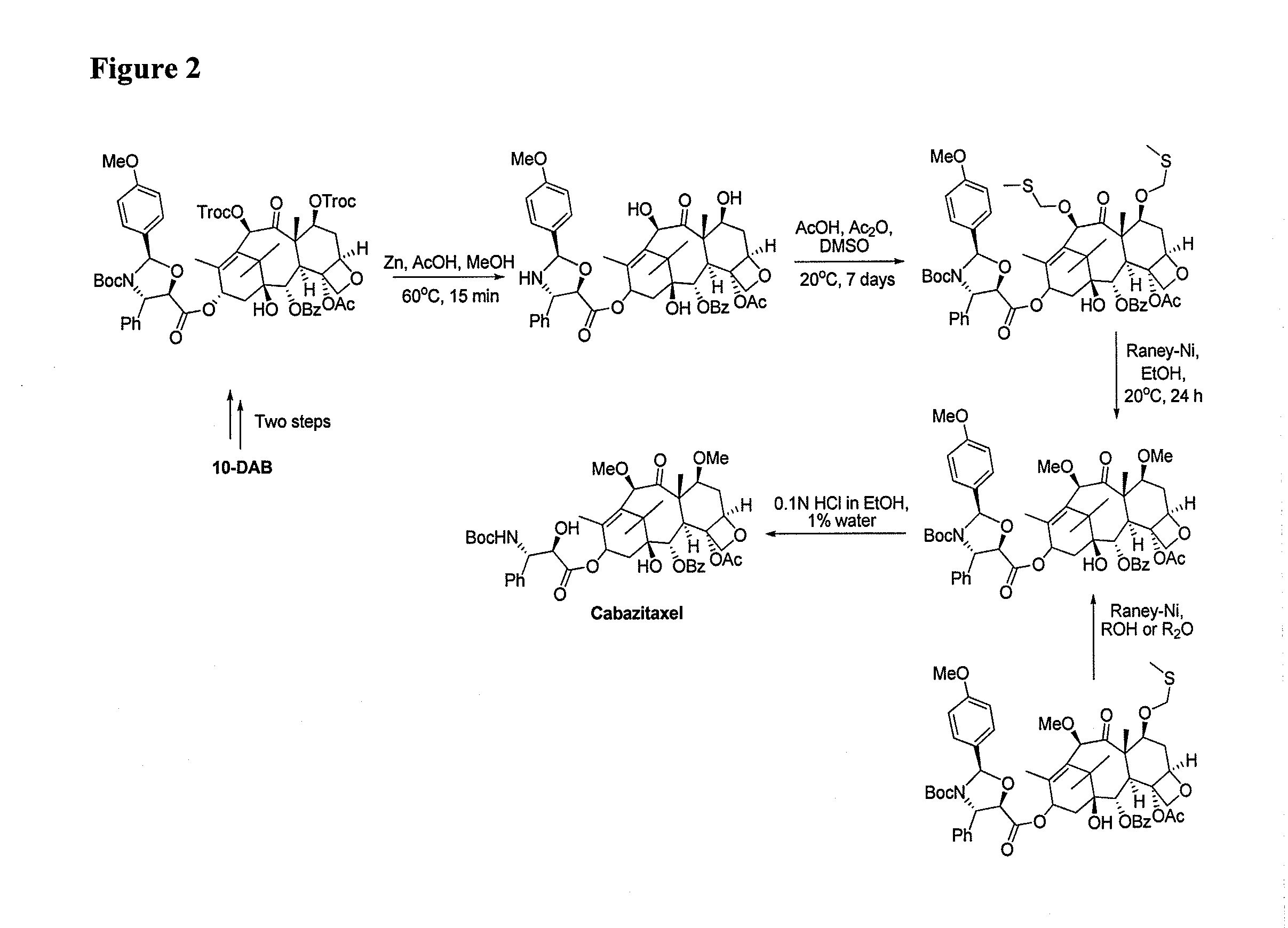Process for making an intermediate of cabazitaxel
- Summary
- Abstract
- Description
- Claims
- Application Information
AI Technical Summary
Benefits of technology
Problems solved by technology
Method used
Image
Examples
example 1
Preparation of 7-(triethylsilyl)-10-deacetyl baccatin III
[0040]Chlorotriethylsilane (3.7 g) was slowly added to a chilled mixture of 10-deacetyl baccatin III (8.0 g) and imidazole (3.1 g) in dimethylformamide (DMF). After stirring at 0° C. to −20° C. until the reaction was completed, the product mixture was slowly added to a mixture of water and toluene and stirred. n-Hexane was added to the slurry and the mixture was stirred. The product was filtered and the wet cake was dissolved in EtOAc. The solution was washed with saturated sodium chloride solution, and the EtOAc layer was separated and concentrated under reduced pressure until most of the EtOAc was removed. n-Heptane was added and replacement distillation was carried out under reduced pressure until most of the EtOAc and n-heptane mixture was removed. n-Heptane was added, stirred, and 7-(triethylsilyl)-10-deacetyl baccatin III was filtered and dried under vacuum at not less than 40° C. to provide 7-(Triethylsilyl)-10-deacetyl...
example 2
Preparation of 10-deacetyl-10-methyl-7-triethylsilyl baccatin III
[0042]A solution of 7-(triethylsilyl)-10-deacetyl baccatin III (21.6 g) was prepared in THF. Then lithium bis(trimethylsilyl)amide (LiHMDS) in THF was added to the solution at not more than −20° C. After stirring, methyl iodide was added dropwise. The mixture was warmed to 0° C. over 1 hour and was then warmed to room temperature. The reaction was quenched with saturated NH4Cl and extracted with THF. The organic layer was concentrated, and THF and n-heptane were added to cause precipitation. The solid was collected and dried under vacuum at not more than 50° C. to provide 10-deacetyl-10-methyl-7-triethylsilyl baccatin III (82% yield).
[0043]1H NMR (400 Hz, MHz, CDCl3) δ 8.13 (d, J=8.0, 2H), 7.62 (t, J=7.2, 1H), 7.49 (t, J=7.6 Hz, 2H), 5.62 (d, J=6.8 Hz, 1H), 4.98-4.97 (m, 1H), 4.96 (s, 1H), 4.97-4.93 (m, 1H), 4.45 (m, 1H), 4.24 (dd, J=60, 8.4 Hz, 2H), 3.90 (d, J=7.2 Hz, 1H), 3.43 (s, 3H), 2.52-2.47 (m, 1H), 2.31 (s, 3H)...
example 3
Preparation of 10-deacetyl-10-methyl baccatin III
[0044]A solution of 10-deacetyl-10-methyl-7-triethylsilyl baccatin III (40.3 g) in THF and 1M tetrabutylammonium fluoride (TBAF) in THF was stirred at room temperature. Water was added to the reaction mixture, and the mixture was then concentrated to provide a solid which was filtered and washed with methyl tert-butyl ether (MTBE). The crude solid was dissolved in THF and was precipitated by the addition of water. The solid was filtered and dried under vacuum at not less than 55° C. to provide 10-deacetyl-10-methyl baccatin III (83% yield).
[0045]1H NMR (400 Hz, MHz, DMSO) δ 8.02 (dd, J=8.4, 6.8 Hz, 2H), 7.68-7.64 (m, 1H), 7.57 (t, J=7.6 Hz, 2H), 5.39 (d, J=6.8 Hz, 1H), 5.28 (m, 1H), 5.01 (m, 1H), 4.92 (d, J=8.0 Hz, 1H) 4.89 (s, 1H), 4.68-4.64 (m, 1H), 4.15-4.11 (m, 1H), 4.02 (s, 2H), 3.75 (d, J=6.8 Hz, 1H), 3.31 (s, 3H), 2.52-2.50 (m, 2H), 2.23-2.22 (m, 1H), 2.19-2.16 (m, 4H), 2.19 (s, 3H), 1.65-1.63 (m, 1H), 1.48 (s, 3H), 0.95-0.92 (...
PUM
 Login to View More
Login to View More Abstract
Description
Claims
Application Information
 Login to View More
Login to View More - R&D
- Intellectual Property
- Life Sciences
- Materials
- Tech Scout
- Unparalleled Data Quality
- Higher Quality Content
- 60% Fewer Hallucinations
Browse by: Latest US Patents, China's latest patents, Technical Efficacy Thesaurus, Application Domain, Technology Topic, Popular Technical Reports.
© 2025 PatSnap. All rights reserved.Legal|Privacy policy|Modern Slavery Act Transparency Statement|Sitemap|About US| Contact US: help@patsnap.com



